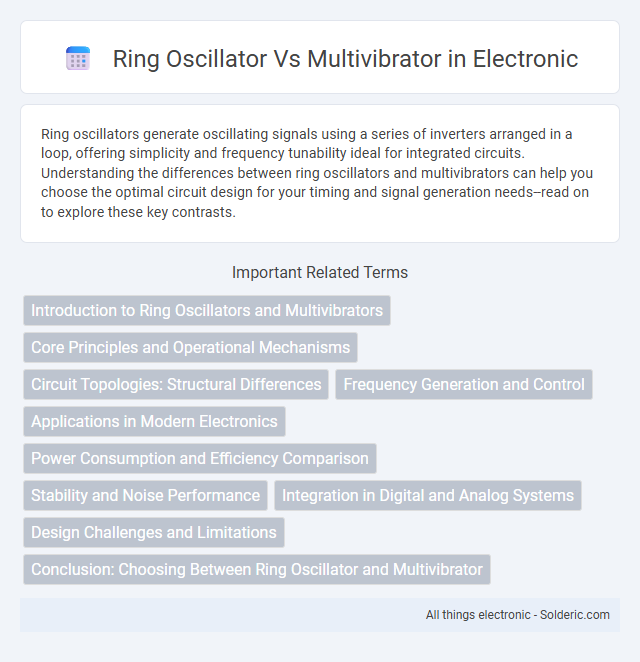Ring oscillators generate oscillating signals using a series of inverters arranged in a loop, offering simplicity and frequency tunability ideal for integrated circuits. Understanding the differences between ring oscillators and multivibrators can help you choose the optimal circuit design for your timing and signal generation needs--read on to explore these key contrasts.
Comparison Table
| Feature | Ring Oscillator | Multivibrator |
|---|---|---|
| Definition | Oscillator made of an odd number of inverters connected in a ring | Electronic circuit generating square wave pulses; types include astable, monostable, and bistable |
| Waveform Output | Periodic square wave oscillations | Square or rectangular pulses depending on configuration |
| Frequency Control | Determined by number of inverters and propagation delay | Controlled by resistors and capacitors values |
| Applications | Clock generation, delay elements, testing IC speed | Timer circuits, pulse generation, flip-flops |
| Stability | Lower frequency stability, frequency varies with temperature and supply voltage | Better frequency stability with design optimization |
| Component Complexity | Simple; uses only inverters | More complex; uses transistors, resistors, capacitors |
| Types | Single type based on inverter ring | Astable, Monostable, Bistable multivibrators |
Introduction to Ring Oscillators and Multivibrators
Ring oscillators consist of an odd number of inverters connected in a loop, generating periodic oscillations critical for delay measurement and clock generation in integrated circuits. Multivibrators, classified as astable, monostable, or bistable, utilize active devices like transistors or operational amplifiers to produce distinct output waveforms for timing, pulse generation, or flip-flop applications. Both devices are fundamental in electronics for signal modulation, with ring oscillators offering simpler, frequency-controlled oscillations and multivibrators providing versatile waveform shaping capabilities.
Core Principles and Operational Mechanisms
Ring oscillators generate oscillations through an odd number of inverters connected in a closed loop, relying on the propagation delay to produce periodic signals. Multivibrators operate based on transistor switching or amplifier feedback to create stable or astable pulse waveforms, classified as monostable, astable, or bistable types. The ring oscillator's frequency is primarily determined by the number of stages and transistor delay, while multivibrators control timing through external resistors and capacitors influencing charge and discharge cycles.
Circuit Topologies: Structural Differences
Ring oscillators consist of an odd number of inverters connected in a loop, creating a feedback path that produces oscillations based on propagation delay. Multivibrators, including astable, monostable, and bistable types, rely on configurations of transistors, resistors, and capacitors to generate or control pulse waveforms through timed charging and discharging cycles. The fundamental structural difference lies in the ring oscillator's inverter loop topology versus the multivibrator's RC timing networks and transistor switching arrangements.
Frequency Generation and Control
Ring oscillators generate frequency through the propagation delay of an odd number of inverters connected in a loop, producing a signal with a frequency determined by the total delay of each stage. Multivibrators, such as astable multivibrators, generate frequency using RC timing components, allowing precise control over oscillation frequency by adjusting resistor and capacitor values. Your choice depends on the desired frequency stability and tuning range, with ring oscillators offering simpler structures and multivibrators providing more flexible frequency control.
Applications in Modern Electronics
Ring oscillators are widely used in modern electronics for frequency synthesis, clock generation, and testing integrated circuits due to their simple design and tunable frequency range. Multivibrators, including astable, monostable, and bistable types, find applications in timing circuits, pulse generation, and waveform shaping essential in communication systems and microcontroller interfacing. Your choice between these oscillators depends on the required signal stability, waveform type, and integration complexity in your electronic design.
Power Consumption and Efficiency Comparison
Ring oscillators typically consume less power than multivibrators due to their simpler digital inverter stages, making them more efficient for high-frequency applications. Multivibrators, especially astable types, often draw continuous current from both power rails, leading to higher power consumption in analog signal generation. Your choice between the two should consider the trade-off between power efficiency and required signal stability or waveform shape.
Stability and Noise Performance
Ring oscillators exhibit lower stability due to their inherent phase noise and sensitivity to process variations, resulting in greater frequency jitter. Multivibrators, particularly crystal-controlled types, offer superior stability with low phase noise and consistent oscillation frequency under varying environmental conditions. Choosing the right oscillator depends on your application's tolerance for noise and frequency precision.
Integration in Digital and Analog Systems
Ring oscillators seamlessly integrate into digital systems as compact, frequency-tunable clock generators due to their simple inverter-based design and compatibility with CMOS technology. Multivibrators, available in astable, monostable, and bistable configurations, offer versatile timing and waveform generation capabilities essential for analog signal processing and pulse shaping. Their distinct circuit architectures enable efficient deployment in mixed-signal environments where precise timing control and waveform stability are critical.
Design Challenges and Limitations
Ring oscillators face design challenges related to frequency stability and sensitivity to process variations, temperature fluctuations, and power supply noise, which can degrade performance in high-precision applications. Multivibrators, however, often struggle with duty cycle distortion and limited frequency range, making them less suitable for applications requiring fine frequency tuning or low jitter. Understanding these limitations helps you choose the appropriate oscillator type based on your specific timing accuracy and stability requirements.
Conclusion: Choosing Between Ring Oscillator and Multivibrator
Ring oscillators provide precise frequency control and are ideal for integrated circuit testing and clock generation, while multivibrators offer versatile waveform generation and simpler design for timing and pulse generation applications. Selecting between the two depends on the required signal stability, frequency range, and implementation complexity specific to the electronic circuit's purpose. For high-frequency and clocking tasks, ring oscillators are preferable, whereas multivibrators are better suited for custom pulse width and timing interval requirements.
Ring oscillator vs Multivibrator Infographic

 solderic.com
solderic.com